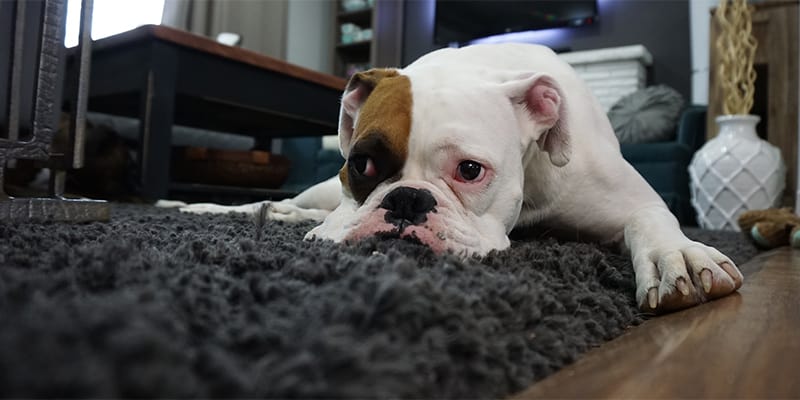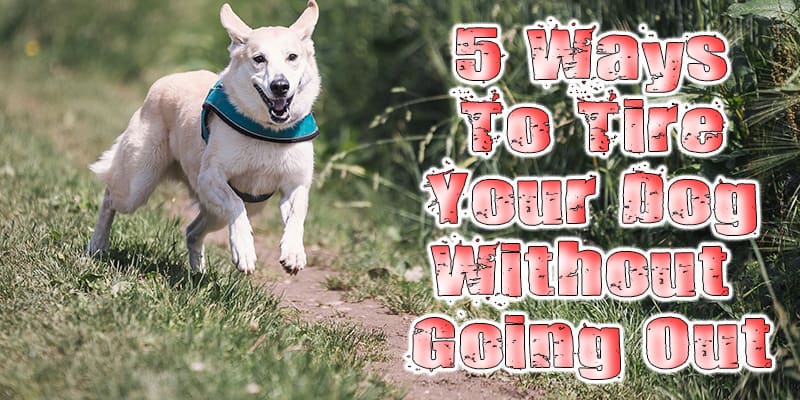I Recommend This Book
Providing a dog with mental and physical stimulation is a vital part of being a responsible owner. Destructive behavior, disobedience and depression are all signs a dog has too much energy.
As most dog owners know, walks are the best ways to provide this stimulation. Nothing beats the combination of physical exercise, exciting smells and freedom of a walk in the woods or park.
Long walks aren’t always possible though. Extreme cold or hot temperatures, for example, can make it dangerous to take your pet outside. Some days you just might not have time for a long walk. Many dogs also have excess energy, even after they’ve been for a long walk.
The good news is there are plenty of ways to tire your dog without a walk. These techniques aren’t meant to replace a walk, but can be useful for providing extra stimulation when your dog needs it.
1. Teach a New Trick
Obedience or trick training is one of the best ways to tire your dog without going outside. New commands demand intense focus from a dog, which is mentally tiring – even in short bursts. Many dogs also love training, as they get your full attention and there are plenty of treats!
It’s a good idea to start with basic commands, such as sit, wait and down. These are difficult for your pet, so they are more tiring, and useful in everyday life. If your dog already knows these commands, you can teach tricks like “rollover” or “spin.”
Make sure these training sessions are always fun for your pet. Use positive methods, such as clicker training and rewards, and give lots of praise when your dog gets it right.
Tip: Mental stimulation is just as important as physical exercise for a dog. You might be surprised at how tired your pet is after a short obedience training session!

2. Play Hide and Seek with Toys
Another great way to provide mental stimulation is to play hide and seek around the house. You’ll need to teach the “wait” command before you play this game, but it’s worth the effort.
Start by showing your dog one of his favorite toys and asking him to “wait.” Then put the toy somewhere he can see it and release him from waiting. If he touches the toy, praise him and give a small treat.
Once your dog starts to understand the game, you can try more difficult hiding places. Eventually, you’ll be able to put the toy anywhere in the home and your pet will find it.
3. Setup a Food Hunt
If your dog eats dry kibble, why not make dinner into a game? Get your dog to “wait,” then sprinkle the kibble around the home. For added mental stimulation, try hiding it behind open doors, under desks or other places your pet has to spend time searching.
Finding dinner is much more interesting than eating from a bowl, as it forces your pet to use his sense of smell to “hunt.” A food hunt can also be useful if your dog eats his dinner too quickly from a bowl.

4. Play Tug of War
While hide and seek is a useful game for mental stimulation, tug of war is great for providing indoor physical exercise. Even playing for a few minutes can tire most dogs – and you might find it’s physically demanding for you too (depending on the size of your dog).
It’s important to play tug of war safely though. If your dog’s teeth touch your hand at any time, the game should stop. You should also teach your pet the “give” command. Use this command whenever your dog is getting over-excited.
Note: I don’t recommend playing tug of war with a puppy. Puppies often haven’t developed bite inhibition yet, so it’s a bad idea to encourage games where teeth are likely to contact skin. Some people also think puppies are more likely to get injured when playing a rougher game like tug of war.
5. Create an Indoor Obstacle Course
Creating an obstacle course in your living room is an excellent way to provide both physical and mental stimulation. You don’t need special equipment for this – just some regular household items and a little creativity.
Here are some examples of obstacles you could create:
- Setup a tunnel by draping a sheet over a set of chairs
- Build a jump with a few cushions on the floor
- Create weaving poles with soda cans
Once you’ve created a few obstacles, you can combine them into a sequence. There are almost endless ways to adjust the course, and active dogs will love tackling whatever you create.
Don’t expect your pet to know what you want though – make sure you teach him how to interact with each obstacle. You can do this by using rewards or luring your pet through each activity.
Of course, obstacle courses and other physical game aren’t suitable for all dogs. If your dog has joint issues or just gets tired quickly, one of the other games is probably a better option.
Remember: Yard-Time Isn’t Enough
Dog owners often attempt to replace a walk by letting their pet spend time in the yard. Some people even install dog doors, such as the models here, so their pet can go outside throughout the day.
While yard-time is better than a dog being cooped up in the house, it doesn’t provide much physical and mental stimulation. Dogs aren’t great at entertaining themselves, even if you leave toys outside, and most gardens don’t contain many new smells to investigate.
Summary
Walks are the best way to provide your dog with mental and physical stimulation, but they aren’t the only way. If you can’t take your pet for a walk, or if he has too much energy even after being outside, then the games in this article can help tire him without leaving the home.
Always remember that mental stimulation is just as important as physical. If your dog has already been for a walk and still has plenty of energy, try obedience training or hide and seek with a toy. These games often challenge your pet in different ways, which can be great for burning extra energy.
